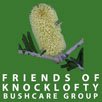|
Leptomeria drupacea
Leptospermum scoparium
Leucopogon collinus
Linum marginale
Lissanthe strigosa
Lomandra longifolia
ViewFlora Descriptions and images
A|B|C|D|E|G-J|L|M-O|P|S-Z
|
Knocklofty Reserve Flora - L
Leptomeria drupacea, common name "Erect currantbush", grows as a much branched, light green, upright bush with slender, angular stems and leaves like tiny scales. The tiny, cream to white flowers have strong sweet honey smell when they appear in late spring through to early summer. The fruit that follow are white to red edible drupes (fleshy fruit enclosing a stone or nut with a kernel) with persistent flowers on top. It is found growing in the sandy heathland south east from the Forest Road carpark on Knocklofty Reserve and other sandy heathland areas in the Reserve. This is another hemiparasitic plant like the Exocarpos species but the host species is unknown. It is rarely found in suburban home gardens due to its hemiparasitic nature.
View Images
Leptospermum scoparium, common name "Common teatree", are found throughout the Knocklofty Reserve and have been planted in many rehabilitation sites. They are open, medium shrubs, sometime a bit straggly, growing 1.5 to 4m high by 1 to 2m wide. They have white flowers during spring through to summer followed by 5 celled, convex topped, woody fruit that remain on the bushes for many years. This species grows in most well drained soils and prefers full sun. It is salt, drought & frost tolerant and an excellent species for revegetation projects. In the home garden, this species should be pruned regularly after flowering to encourage fresh new growth and maintain a good shape. The variety with pink to red flowers originated from New Zealand and may suffer from sooty mould in Hobart gardens. For revegetation projects it may be prudent to propagate the new plants from plants found in the revegetation site.
View Images
Leucopogon collinus, common name "White beardheath", is a small, upright, woody shrub growing 30 to 50cm high by 30 to 50cm wide, with small, narrow, blunt pointed, dark green leaves. The tiny, white, tubular flowers that have a bearded throat appear in spring through summer. This species is found in the sandy heath areas south east of the Forest Road carpark and downhill from the Reflecting Pond in Knocklofty Reserve. It prefers light, free draining, and well mulched soils in partial shade if planted in a home garden.
View Images
Linum marginale, common name "Native flax", is a slender, erect, perennial herb with multiple blue flowers that often have darker veins at the centre of the five rounded petals. It grows from 30 to 40cm high in a wide range of locations on the Knocklofty Reserve, specifically along the Summit loop track and along the side of the Southern Trail. It prefers full sun but is short lived in dry locations. So, well mulched, moist, free draining soils would be suitable in home gardens.
View Image
Lissanthe strigosa, common name "Peachberry heath", is a compact woody shrub growing 10 to 30 cm high by 20 to 30 cm with smooth stems. The pink then white, winter through spring flowers are followed by small white berries. This species prefers well drained & mulched sandy soils in part shade, but is found throughout the Knocklofty Reserve as an understory plant. It may be confused with young gorse plants but gorse have hairy stems.
View Images
Lomandra longifolia, common name "Spiny-headed mat-rush" is a dense tussock, perennial herb, growing 0.5 to 1 m high and spreading up to 1m wide. The cream to brown flower spikes appear in spring and are followed by shiny golden brown fruit. This species is very hardy in most soils and prefers full sun. In home gardens, it is best to cut the leaves down hard after the flowers have finished. It grows throughout the Knocklofty Reserve, especially in large swathes in an area near the summit north of the Southern Trail.
View Images
|



